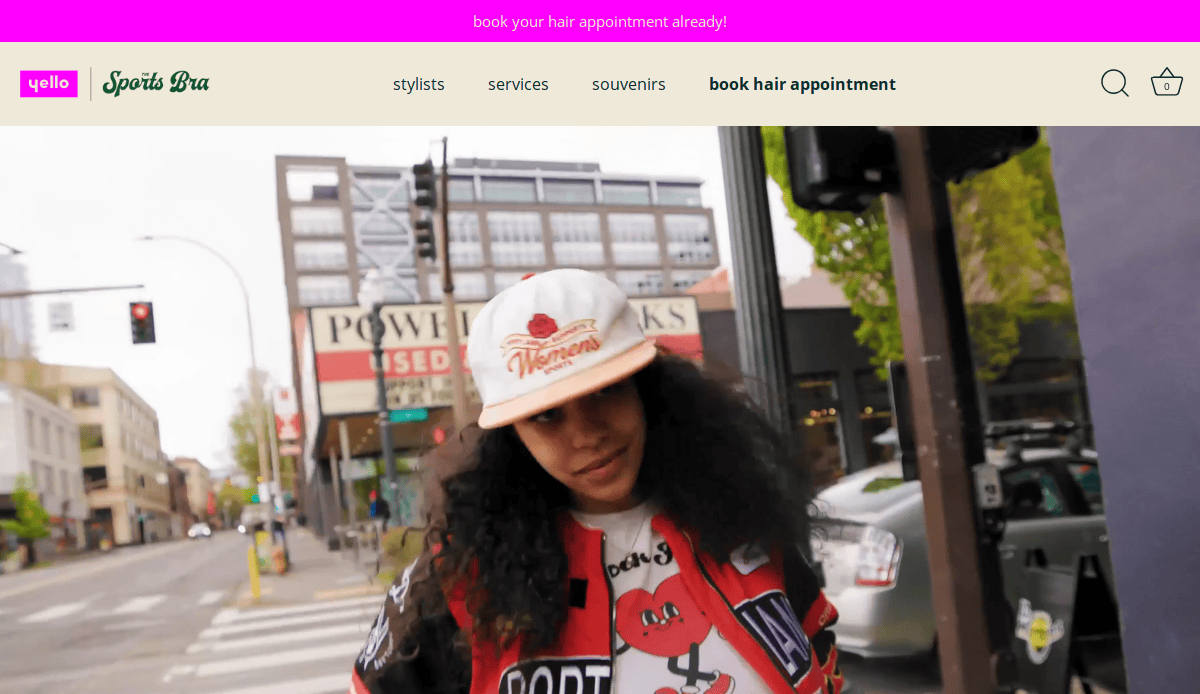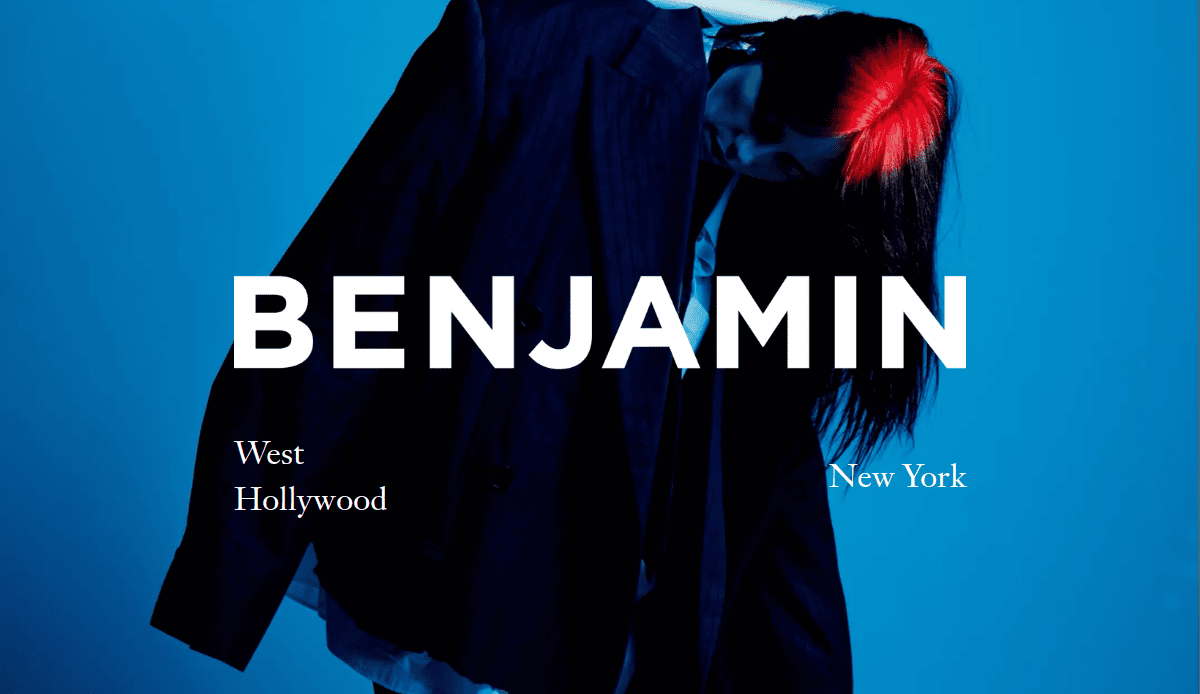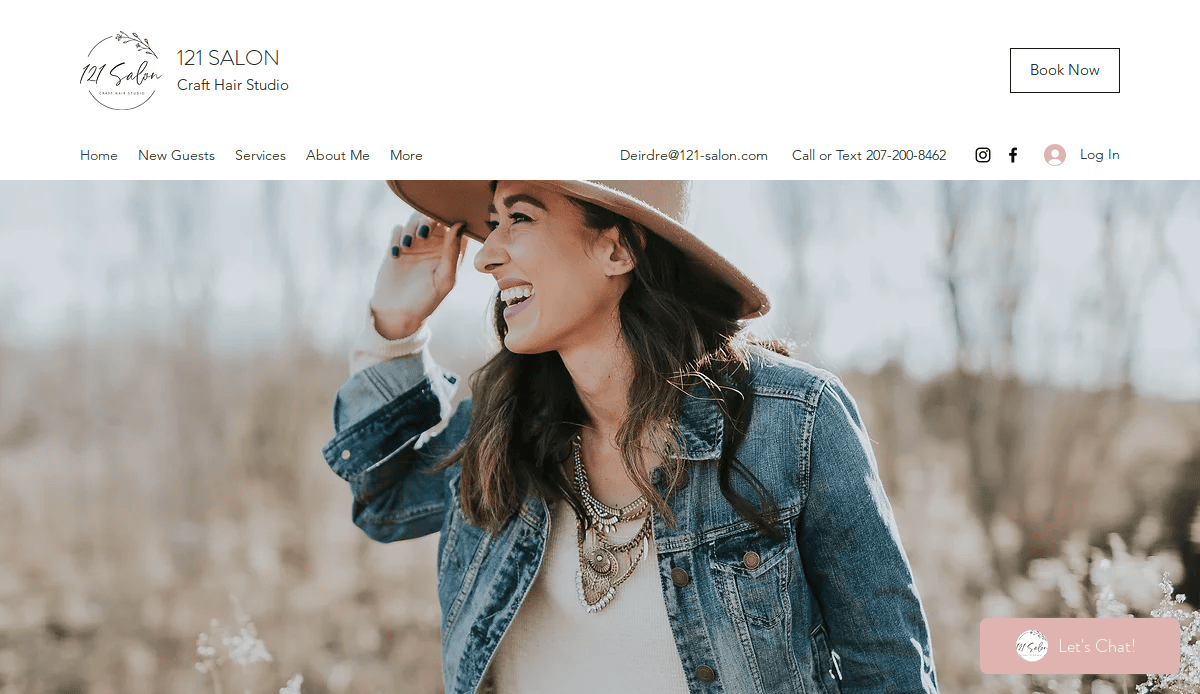Just looking for our Best Salon Website examples list?
Your key takeaways:
- First Impressions Matter: Your website is often the first interaction potential clients have with your salon. A visually appealing and user-friendly site can significantly influence their decision to make an appointment.
- Mobile Optimization is Crucial: With the increasing use of smartphones, ensuring your website is mobile-friendly is essential. A responsive design enhances user experience and can improve your search engine rankings.
- SEO Drives Local Traffic: Implementing effective SEO strategies, such as local keyword optimization and maintaining consistent business information across platforms, can boost your salon’s visibility in local search results.
- User-Centric Website Design: An intuitive navigation system, fast loading times, and accessible design elements contribute to a positive user experience, encouraging visitors to explore your services further.
- Essential Features: Incorporating features like an online booking system, service menu with pricing, team bios, and client testimonials can enhance functionality and build trust with potential clients.
- Showcasing Your Work: Displaying high-quality images of your services, before-and-after transformations, and client testimonials can effectively amplify your expertise and attract new clients.
- Content Marketing for SEO: Regularly updating your website with relevant content, such as blog posts on hair care tips or styling trends, can improve SEO and position your salon as an industry authority.
- Security and Trust Signals: Implementing SSL certificates and displaying privacy policies can enhance your website’s security, build trust with visitors, and protect client information.
- Analyzing and Improving Performance: Utilizing analytics tools to monitor website traffic and user behavior can provide insights for continuous improvement and optimization.
- Integrating Social Media: Linking your website to your salon’s social media profiles and displaying user-generated content can foster community engagement and attract a broader audience.
By focusing on these key areas, you can create a compelling and effective online presence that attracts visitors and converts them into loyal clients.
Why Great Salon Website Design Matters for Your Business
In the highly competitive world of hair styling, having a website that looks great and functions seamlessly is more important than ever. A well-designed site can make all the difference in converting a casual visitor into a loyal new client. Your website is often the first interaction people have with your salon business, and just like the first impression they get when they walk through your door, it needs to leave them with a lasting, positive impact.
An effective website design isn’t just about aesthetics; it’s about creating an experience that encourages bookings and builds trust with visitors. The user experience must be intuitive, allowing visitors to easily find their way to services, book a session, and explore what makes your salon unique. By integrating features like a streamlined booking platform and a beautiful exhibition of your services, your website becomes a powerful tool to grow your salon.
Whether you’re using a website builder or working with professionals to create one, having a clear, accessible navigation structure is essential. This guide explores how great web design can turn your hair salon website into a customer-generating machine. From essential design elements to practical tips on improving your online presence, let’s dive into the strategies that will help your salon attract and retain more clients.
Website Planning & Purpose: Laying the Foundation for a Successful Site
The website planning phase is critical for businesses looking to create a high-performing, effective online presence. This stage lays the foundation for the entire design process and ensures that the final website will meet the business goals and align with the salon’s brand identity. For salon owners, this phase should be approached with a clear strategy in mind, focusing on both the business objectives and the user’s needs. Planning is about identifying what your website will achieve and how to effectively communicate those goals through design, content, and functionality.
The first step in planning is understanding the purpose of your website. What do you want visitors to do when they land on your site? Whether it’s booking an appointment, exploring your services, or learning more about your stylists, the website’s primary goal must be clear. For many salon owners, the purpose of their site is to convert visitors into new clients by encouraging them to make a reservation and schedule consultations. Establishing this purpose upfront helps ensure that the design supports these objectives.
Once the purpose is defined, it’s time to map out the content structure. This includes planning the key pages such as the homepage, service offerings, about us, team, gallery, and contact information. Each page should have a clear function, whether it’s showcasing your salon’s offerings, displaying client testimonials, or providing an easy way to access the online booking system. Ensuring an intuitive layout with seamless navigation will contribute to a positive user experience that encourages visitors to stay longer and interact with the site.
The planning phase also involves selecting the right platform for your site. Whether you choose to use a website builder or work with a professional web design team, the platform should be flexible enough to meet your needs while also being easy to manage. One of the most crucial decisions during this phase is deciding how the online booking system will be integrated into the site. A well-implemented system ensures that clients can easily schedule appointments at their convenience, improving both customer satisfaction and business efficiency.
Moreover, understanding the importance of SEO is essential in this phase. Planning for SEO ensures that your site will be discoverable by prospective clients in your local area. From selecting the right keywords to ensuring that the website loads quickly, SEO should be part of the initial planning process.
For more details on the foundational principles of web design, check out our article on the Core Principles of Web Design: A Guide for Beginners. With a strong plan in place, your website will be positioned for success, helping to attract and retain more clients while enhancing the overall performance of your salon business.
Design Principles: Creating a Visually Appealing and User-Friendly Site
When designing a site, it is crucial to focus on both visual appeal and functionality. A well-designed website reflects the essence of your salon’s brand and ensures that visitors have an intuitive and enjoyable experience. Below are key design principles to consider when building an effective website design that attracts and retains clients.
First and foremost, visual hierarchy plays a pivotal role in guiding users through the site. Your website should be organized in a way that leads visitors to the most important information first, whether it’s the services you offer, your pricing, or the ability to make an appointment. By using font size, color contrast, and strategic placement, you can create a clear flow that directs the user’s attention to key sections of the page. For example, the call-to-action buttons like “Book Now” should stand out and be easily accessible.
Another important principle is consistency. Your website’s design should be uniform across all pages, using the same color palette, fonts, and layout style. Consistency enhances user experience by making the website feel cohesive and easy to navigate. It also helps reinforce your salon’s identity. Choose colors that align with your brand’s personality – whether it’s elegant, modern, or vibrant – and use them thoughtfully throughout the site.
Responsiveness today is essential. With many users accessing websites on mobile devices, ensuring that your website is mobile-friendly is non-negotiable. A responsive design adapts to different screen sizes, ensuring that your website looks great and functions well on phones, tablets, and desktops. This also positively impacts SEO, as search engines like Google prioritize mobile-friendly websites in their rankings.
Equally important is simplicity. A cluttered website can overwhelm visitors and lead them to leave quickly. Clean, minimalist design allows your content to shine without distractions. Keep navigation menus simple and intuitive, making it easy for visitors to find what they need, whether it’s exploring your services or booking an appointment. Avoid overwhelming visitors with too much text or too many options. Instead, focus on delivering the essentials in a visually appealing way.
Fast loading speed is another crucial aspect of good website design. Studies show that visitors are more likely to abandon a website that takes longer than a few seconds to load. Optimize images, reduce unnecessary scripts, and choose a reliable hosting platform to ensure that your site loads quickly. This improves UX and boosts SEO rankings.
Accessibility is often overlooked, but it is essential in reaching a wider audience. Make sure your website is accessible to all users, including those with disabilities. This includes ensuring that text is legible, providing alt text for images, and ensuring that the site can be navigated using a keyboard. Following web accessibility guidelines ensures that your website is inclusive and enhances your reputation as a business that cares about all of its clients.
Lastly, strong imagery is vital. The visuals on your site should amplify your services, team, and the atmosphere of your salon. High-quality photos of haircuts, color treatments, and stylists in action help prospective clients connect with your brand and understand the level of service they can expect. Featuring real-life transformations or before-and-after images can also enhance credibility and encourage people to make a reservation.
Incorporating these design principles into your website ensures that it will look professional and attractive and provide a smooth, enjoyable experience for your visitors. By focusing on visual appeal, responsiveness, simplicity, and accessibility, your website can become a powerful tool for growing your salon business and attracting new clients.
Content & Navigation: Structuring Your Site for Optimal User Experience
When designing, one of the most critical aspects to consider is the structure of your content and navigation. A well-organized website ensures that visitors can easily find the information they’re looking for, leading to a better user experience and higher conversion rates. Proper content and navigation planning are essential to keep your website intuitive, engaging, and effective in converting visitors into clients.
Structuring Content
First, determine the core pages that your website needs to function effectively. These typically include a homepage, services page, team or about us page, booking or contact page, and a gallery. Each of these pages serves a specific function and must be designed to guide visitors toward booking an appointment or exploring your salon’s services.
The homepage is the first impression visitors will have of your business. It should provide a clear and welcoming introduction to your brand, with a concise message that immediately communicates who you are and what services you offer. The homepage should include prominent calls-to-action (CTAs), such as “Book an Appointment” or “Explore Our Services,” directing visitors to the most important pages. Highlight key elements, such as your unique value proposition, testimonials, and any promotions or offers that would encourage people to book.
The services page is one of the most important sections of your website. Here, you should list all the services you offer in clear, easy-to-read sections. Include detailed descriptions of each service, along with pricing information if possible. Consider organizing your services by category (e.g., haircuts, color treatments, special offers), and use strong imagery to showcase your work. This will help clients visualize what they can expect when they take an appointment at your salon. Offering easy-to-find information about your online booking system will also help guide visitors towards making a reservation.
The about us page is another critical component. This page helps humanize your salon by introducing your team of stylists and providing insight into your salon’s atmosphere and values. Including professional photos and short bios of your team members will help visitors get to know your staff and create a sense of trust. It’s also important to include any credentials or specializations, such as certifications or awards, that set your salon apart from others in the area.
The reservation or contact page must be simple and straightforward. Alternatively, ensure that there is clear contact information, including phone numbers, email addresses, and links to your social media profiles. Consider incorporating a contact form for inquiries or special requests. Having this information easily accessible increases the likelihood that visitors will take the next step and schedule an appointment.
Lastly, the gallery page serves as a visual display of your salon’s work. Use high-quality images to display before-and-after transformations, styled haircuts, color treatments, or even events hosted at your salon. This page helps build credibility and inspires confidence by showcasing the quality and range of services your salon offers.
Organizing Navigation for Easy User Access
Once your content is structured, you need to organize your website’s navigation to ensure visitors can easily find what they are looking for. The navigation bar should be clear, concise, and accessible from every page of the website. Most websites follow a traditional layout with key pages like those referenced above; however, depending on the scope of your services, you might need to add other sections, such as a “Blog” or “FAQ” page.
A good menu bar should always be present at the top of the page, providing visitors with quick access to the most important areas of your website. Consider using drop-down menus if you have multiple categories of services, which will make it easier for clients to navigate without feeling overwhelmed. For example, a drop-down menu for the “Services” page could include options like “Haircuts,” “Color,” “Bridal Services,” and “Special Treatments,” each linking to detailed subpages about those services.
To improve the overall UX, ensure that guidance is consistent throughout the site. Visitors should never feel lost when browsing. It’s important to include a search bar at the top or bottom of the page to allow users to quickly search for specific services or team members, especially if your website contains a large amount of content.
In addition to the main navigation, adding internal links within the content will improve usability and SEO. For instance, when discussing a service on the services page, you could link to the corresponding stylist bio or portfolio gallery. This will encourage visitors to explore more of your website and help search engines understand the relationship between different pages on your site.
Another essential feature to consider is making your theme mobile-friendly. With more clients making reservations on their smartphones, your mobile navigation must be just as intuitive as the desktop version. A solid suggestion is a hamburger menu. It’s a great option for mobile devices, allowing users to access the main sections of the website without cluttering the screen.
To learn more about marketing your salon effectively and integrating these navigation and content strategies into your overall marketing plan, check out our article on the Best Marketing Strategies for Hair Salons.
Visual Elements: Enhancing User Experience and Brand Identity
In the world of website design, visual elements are not just decorative; they are crucial components that enhance the user experience and reinforce the salon’s brand identity. A well-designed website can captivate visitors, encourage engagement, and ultimately lead to more bookings. The right visuals create a welcoming atmosphere, convey professionalism, and allow visitors to feel confident in your salon’s services. Here’s how visual elements play an integral role in both supporting user experience and strengthening your salon’s brand.
First and foremost, the color palette you choose sets the tone for the entire visitor experience. Colors can evoke emotions and help establish the mood of your salon. For instance, soft, neutral tones such as pastels can create a calm and soothing environment, ideal for spas and wellness salons. On the other hand, bold, vibrant colors might work better for trendy, high-energy hair salons. The colors should reflect your brand’s personality and services, ensuring consistency across all your marketing materials, including your physical salon space and social media profiles. A consistent color scheme throughout the website also promotes a sense of professionalism and coherence that enhances user trust.
Typography also plays a key role in defining your brand’s personality and improving readability. Choose fonts that align with your salon’s aesthetic—whether that’s sleek and modern, elegant, or casual—and ensure they are legible on all devices. Use font sizes appropriately to create a visual hierarchy on the page. For example, larger fonts can draw attention to headings and calls-to-action, while smaller fonts should be used for body text. The right typography enhances the overall experience by making the site easy to read and navigate, encouraging visitors to stay on your site longer and engage with your content.
Imagery is arguably the most impactful visual element on a website. High-quality photos are essential to showcasing the expertise and style of your salon. Featuring images of your team in action, before-and-after photos, and the interior of your salon can help prospective clients visualize the experience they will have when they walk through your doors. It’s important to showcase your work authentically. Real client transformations, vibrant colors, and styled haircuts should be front and center. Images should also reflect your target audience and align with your brand’s message, whether you specialize in cutting-edge styles or luxury services. These visuals make the website aesthetically pleasing and provide credibility and inspiration for clients looking to make an appointment.
Beyond static images, video content is becoming increasingly popular. A short video that introduces your business, amplifies your team, or explains the booking process can be a powerful way to connect with clients. Videos help put a face to your business, creating a more personal connection with visitors. A well-produced video can provide an immersive experience that text alone cannot achieve. Whether it’s a virtual tour of your salon or a demonstration of your hairstyling techniques, video content engages users and keeps them on your site longer.
Whitespace is another visual element that should not be overlooked. While it may seem like an unnecessary design feature, whitespace (or negative space) is vital for creating a clean and uncluttered layout. When used strategically, whitespace allows each element of your website to breathe, preventing the page from feeling overcrowded. It helps improve readability, focus attention on important content, and make the navigation experience more intuitive. Whitespace also gives the user’s eye a break, making the site feel less overwhelming and more comfortable to navigate.
Icons and buttons are also critical visual elements that directly impact usability. Clear, well-designed icons guide users to key sections of the website, such as services and the contact page. Buttons should be easily distinguishable, visually appealing, and strategically placed to encourage users to take action. Calls-to-action should stand out with contrasting colors or shapes to make it easy for users to find and click them. The design of these elements should align with your overall aesthetic while also being functional and accessible.
The layout in its entirety is a vital visual consideration. A clean and organized layout helps ensure that your visitors can quickly find what they’re looking for without unnecessary friction. Group related content together, and avoid cluttering the page with too many competing elements. The navigation menu should be easily accessible, and important actions, like booking an appointment or viewing your services, should be prominently featured. By structuring your website in a user-friendly way, you make it easier for prospective clients to interact with your salon and ultimately book a session.
The visual elements of your website are an extension of your salon’s brand identity. They convey professionalism, style, and expertise in a way that words alone cannot. When combined thoughtfully, the right colors, typography, imagery, and layout create a visually compelling website that reflects your salon’s unique personality while providing a seamless and enjoyable user experience. To see how the best websites in the industry implement these design principles, take a look at our article on the Best Hair Stylist Websites. A strong visual identity on your website attracts the right clients and keeps them coming back for more.
Ongoing WordPress Maintenance: Ensuring Your Site Stays Secure and High-Performing
The launch of a WordPress site is just the beginning. Maintaining it is an ongoing process that ensures your site remains secure, functional, and optimized for performance. Regular maintenance is essential to ensure that your website continues to attract clients, facilitate bookings, and uplift your services effectively. Neglecting maintenance can lead to slow loading times, security vulnerabilities, and even a loss of search engine rankings.
One of the primary aspects of ongoing maintenance is updating WordPress software, themes, and plugins. WordPress frequently releases updates to enhance functionality, fix bugs, and improve security. It’s critical to regularly check for updates and apply them promptly. Many WordPress themes and plugins also release their own updates to keep up with the latest features and security patches. If you’re not consistently updating these components, your site can become susceptible to hacking attempts or incompatible with newer technologies.
Backing up your website is another critical task. Regular backups are essential in case your site encounters an issue or is compromised. If you don’t have a reliable backup system in place, any issue—whether a server failure, malicious attack, or accidental data loss—could result in a significant setback for your salon business. Scheduling automatic backups, or manually backing up your site on a regular basis, can help safeguard your content and user data.
Another important aspect of ongoing maintenance is security monitoring. Company websites often store sensitive client information, including contact details and payment information. To protect this data and maintain the trust of your clients, regular security checks should be part of your maintenance plan. Using security plugins, setting up firewalls, and ensuring that your website uses SSL certificates are key steps in protecting your website from security breaches. Additionally, conducting routine scans for malware and checking for vulnerabilities in your WordPress installation can help prevent attacks before they happen.
Website performance optimization is also a crucial part of maintenance. A slow-loading website frustrates visitors and also harm your SEO rankings. Regularly checking and optimizing website speed should be a part of your maintenance routine. This includes optimizing images, cleaning up unused files, and using caching tools to reduce load times. Fast-loading websites improve user experience, increase conversion rates, and contribute to better rankings in search engine results.
It’s also important to conduct regular content updates. Every website needs fresh, up-to-date content to remain relevant. Regularly updating your service offerings, pricing information, team bios, and portfolio images keeps your site engaging for returning clients and encourages new clients to explore your services. A blog or news section can also be a great way to keep your content fresh and improve SEO rankings by targeting long-tail keywords and answering frequently asked questions.
Another element of ongoing maintenance is testing and monitoring. Periodically checking that all the links, forms, and buttons on your website are functioning properly is essential. Broken links or forms that don’t submit correctly can frustrate clients and lead to missed opportunities. Monitoring website analytics also provides insights into how visitors are interacting with your site, allowing you to make adjustments to improve user experience and increase conversion rates.
In addition, SEO maintenance should be part of your ongoing WordPress maintenance routine. SEO is not a one-time task but an ongoing process. Keeping your website optimized for search engines involves monitoring keyword rankings, updating meta tags and descriptions, and improving the content’s relevance over time. Regularly analyzing your website’s SEO performance allows you to adjust your strategy and stay ahead of the competition.
To ensure that your site remains functional, secure, and effective in helping you grow your salon business, it’s essential to have a comprehensive maintenance plan. Whether you handle it in-house or partner with a web design and maintenance service, ongoing attention to updates, security, performance, and content will keep your website running smoothly and your clients engaged. By investing in routine maintenance, you protect your salon’s digital presence and ensure a seamless experience for your clients.
20 Best Hair Salon Website Designs
1. The Hair Bar
Location: New York, NY
- Elegant and Simple Design: Clean, minimal design that focuses on high-quality visuals of the salon’s services.
- Online Booking: Seamless booking system integrated into the website, allowing clients to make appointments easily.
- Clear Service Menu: The services and pricing are easy to navigate, making it simple for prospective clients to understand what’s offered.
2. Nine Zero One Salon
Location: Los Angeles, CA
- Stylish & Trendy Design: The website matches the upscale, fashionable vibe of the salon, with bold imagery and modern design elements.
- Celebrity-Endorsed Content: Featuring testimonials from celebrity clients helps build trust and appeal to high-end clientele.
- Effective Visual Portfolio: The website features a gallery of stunning before-and-after images showcasing the salon’s skills.
3. Rita Hazan Salon
Location: New York, NY
- Strong Brand Identity: The website reflects Rita Hazan’s iconic brand with elegant design and sophisticated color choices.
- Integrated E-Commerce: A seamless online store for products encourages clients to purchase professional hair products.
- User-Friendly Navigation: The site’s intuitive layout helps users easily move to make appointments or learn more about the services.
4. Aveda Institute
Location: Various locations across the US
- Holistic Design: The website follows the Aveda brand’s eco-friendly message with natural design elements and muted color tones.
- Educational Content: The website offers educational resources about hair care and beauty, building trust and establishing authority.
- Clear Call-to-Actions: Clear and easy-to-navigate buttons for booking appointments and finding salon locations.
5. Sally Hershberger Salon
Location: New York, NY
- Luxury Aesthetic: The design is sleek and sophisticated, aligning with the luxury experience the salon offers.
- High-Quality Visuals: Stunning photos and videos amplify the expertise of the stylists and the atmosphere of the salon.
- Detailed Stylist Profiles: Clear information on each stylist’s specialties, ensuring clients know who to book with.
6. Groom Service
Location: New York, NY
- Content-Rich Pages: Provides detailed information on key services, enhancing SEO and user understanding.
- User-Centric Design: Prioritizes essential information like booking options and social media links on the homepage.
- Responsive Layout: Ensures optimal viewing experience across all devices.
7. Fabio Doti Salon
Location: New York, NY
- Luxury Aesthetic: Combines elegant design with a personal touch to appeal to high-end clientele.
- Social Media Integration: Incorporates real-time social feeds to display the salon’s dynamic environment.
- Team Profiles: Detailed stylist bios help clients choose the right professional for their needs.
8. Fringe Salon NY
Location: New York, NY
- Clear Call-to-Action: Prominent “Book Now” button on the homepage encourages immediate engagement.
- Media Recognition: Showcases features in renowned magazines to establish authority.
- Mobile-Friendly Design: Optimized for various devices, ensuring consistent user experience.
9. Honey Rose Aesthetics
Location: San Diego, CA
- Engaging Video Content: Full-page video narrates the client journey, offering an immersive experience.
- SEO-Friendly Structure: Dedicated pages for core services enhance search engine visibility.
- Trust Signals: Displays certifications and positive client testimonials to build credibility.
10. Yello Salon
Location: Chicago, IL
- Energetic Branding: Consistent use of a neon color palette reflects the salon’s vibrant personality.
- Integrated E-Commerce: Combines Mangomint and Shopify to offer products and manage salon inventory seamlessly.
- Client Testimonials: Features heartwarming reviews to build trust with potential clients.
11. Salon Benjamin
Location: New York, NY
- Elegant Design: The minimalist design emphasizes the salon’s luxurious services.
- Detailed Services Breakdown: Each service has a dedicated page with descriptions, making it easier for clients to understand what to expect.
- Easy Navigation: A top bar navigation menu allows users to access all parts of the website with ease.
12. Bumble and Bumble Salon
Location: New York, NY
- Professional Branding: The website’s design aligns with Bumble and Bumble’s branding, with a clean, modern aesthetic.
- Interactive Features: The website allows visitors to explore the brand’s products and services through interactive content.
- Client-Focused Content: The site provides tailored recommendations and content based on the client’s interests and needs.
13. Ritual Salon
Location: Rochester, NY
- Comprehensive Service Listings: Every service is well-detailed, including prices, descriptions, and stylist recommendations.
- Strong Visuals: High-quality images help the salon amplify its services and client transformations effectively.
- Mobile Optimized: The salon website is optimized for both mobile and desktop users, ensuring a seamless experience.
14. 121 Salon
Location: New York, NY
- Prominent “Book Now” Button: Encourages immediate action by making appointment scheduling straightforward.
- Client Reviews: Features testimonials to build trust and credibility.
- Sticky Chat Widget: Enhances customer engagement by allowing real-time inquiries.
15. Artika Salon
Location: Los Angeles, CA
- Intuitive Navigation: Features a transparent “Book Now” button with a hover effect, facilitating easy appointment scheduling.
- Visual Appeal: Single-column photo gallery highlights various areas of the salon, providing a virtual tour experience.
- Mobile Optimization: Responsive design ensures seamless browsing across devices.
16. The Cut
Location: Los Angeles, CA
- Streamlined Service Menu: Services are clearly listed, with accompanying images that highlight what clients can expect.
- Simple Booking System: Easy and accessible online booking integrated into the homepage.
- Interactive Features: The website offers interactive elements like quizzes or style selectors to engage users.
17. Toni & Guy
Location: Dallas, TX
- International Branding: The website follows the brand’s established global identity, with strong colors and professional imagery.
- Salon Locator: Easy-to-use tool that helps clients find nearby locations.
- Booking and Service Details: Detailed information on services, pricing, and booking processes.
18. Spoke & Weal
Location: San Francisco, CA
- Elegant Design: Simple, yet elegant design that emphasizes the beauty of the salon’s craft.
- Service and Price Transparency: The website provides clear details about each service, including its price.
- Appointment Integration: Easy online appointment-making system ensures that visitors can schedule appointments directly on the site.
19. Shag Hair Salon
Location: Miami, FL
- Creative Layout: Fun, yet professional design that reflects the salon’s youthful vibe.
- Interactive Booking: Clients can choose services and stylists through an interactive reservation system.
- Service Descriptions: Every service is well-explained with visuals, offering a comprehensive understanding for users.
20. SHEAR Salon
Location: Stroudsburg, PA
- Cohesive Branding: The website aligns perfectly with the salon’s upscale and clean aesthetic.
- Online Appointment System: Easy-to-use scheduling interface that reduces friction for potential clients.
- Client Testimonials and Reviews: Feature client reviews to build trust and authenticity.
Take the Next Step in Building Your Successful Salon Website
Designing your website is an essential step in establishing a strong online presence for your salon. A well-crafted, user-friendly website helps you attract prospective clients and allows you to highlight your salon’s services and professionalism. From the initial design phase to integrating an online booking system, every detail of your website plays a crucial role in growing your hair salon business.
If you’re ready to create a professional salon website that reflects your brand and meets the needs of your clients, it’s time to get started. This ultimate guide to building a functional website will help you every step of the way, covering best practices, essential website features, and how to ensure your site works effectively for your salon and spa. Whether you’re designing your beauty salon’s first site or updating your existing one, this step-by-step guide ensures you have everything you need for a sleek design that converts visitors into loyal clients.
A professional website is an investment that pays off by streamlining your business, improving your salon and spa management, and helping clients book their next appointment with ease. Don’t wait to elevate your salon’s digital presence—visit your website now to see how it can transform your beauty business.
Ready to make your salon website work for you? Get started here with our expert services to build a website tailored for your beauty business.
Common Questions About Hair Care Business Web Design, Answered
How Do I Create a Website That Attracts Clients?
Creating a website that attracts clients starts with understanding your audience and offering easy navigation, clear service descriptions, and an online booking system. A well-crafted website for your salon should highlight your expertise in the beauty industry and allow potential clients to explore your services and easily book appointments. The website design should reflect your salon’s brand identity and be functional, offering visitors a seamless experience from landing on your page to making a booking. If you need a website for your beauty salon, focusing on user-friendly design and functionality is key.
What Features Are Essential for a Beauty Salon Website?
A website that’s designed with the right features is crucial for your business. Key features include a clear service menu, booking functionality, and client testimonials. A functional website ensures your clients can easily book appointments online. Additionally, beauty website design emphasizes the importance of mobile optimization so that clients can visit your website on any device and have a smooth experience.
Why Is Website Hosting Important for My Salon Site?
Web hosting plays a critical role in the website creation process, especially for salons. A professionally designed website requires a hosting solution that can handle the volume of traffic and ensure your site is accessible 24/7. Poor hosting can result in slow load times, which can drive clients away. A great website for your salon needs fast loading times to improve user experience and SEO. Choosing reliable web hosting can make or break the performance of your salon site. Explore more about choosing the right website hosting options in our blog.
How Can I Make My Website Stand Out in the Beauty Industry?
To make your website stand out, the overall design should be unique and visually appealing, showcasing your salon’s personality. A well-crafted website provides a design experience that resonates with your target audience, whether that’s modern and sleek for a trendy salon or calm and inviting for a spa-like atmosphere. Your salon name should be prominently displayed, along with a clear call to action for booking services. Focus on delivering website content that speaks directly to the needs of the beauty industry and demonstrates why your salon is the right one for potential clients.
How Can I Improve SEO?
SEO is crucial for making sure that your website for search stands out among competitors. To optimize your website, you must include relevant keywords and ensure your website design emphasizes the services you provide. Beauty salons especially need to focus on local SEO so that clients searching for nearby salons can easily find you. Adding high-quality website content with optimized headings and meta descriptions can help drive organic traffic. Additionally, optimizing images, utilizing structured data, and creating blog content focused on design and functionality can significantly boost your SEO ranking.
What Makes a Website Functional and User-Friendly?
A functional website should be easy to navigate and enable clients to book appointments effortlessly. The layout should be clean, with clear categories for services, pricing, and your team. Additionally, your salon site should load quickly and be mobile-friendly, ensuring that visitors on any device can browse and make an appointment with ease. The website must provide a seamless experience from the homepage to the booking page, and should reflect your salon’s identity in a user-friendly way.
How Do I Ensure My Website Is Secure?
Website security is essential for protecting client information and ensuring your website operates smoothly. Using HTTPS, keeping plugins updated, and implementing strong passwords are critical steps in securing your website. If your website is compromised, it can result in a loss of business and trust. Protecting your website content and maintaining a secure site should be a priority. This website is crucial for maintaining the integrity of your hair salon business and ensuring clients can safely book their appointments. Check our post on website hosting and security for more tips.























